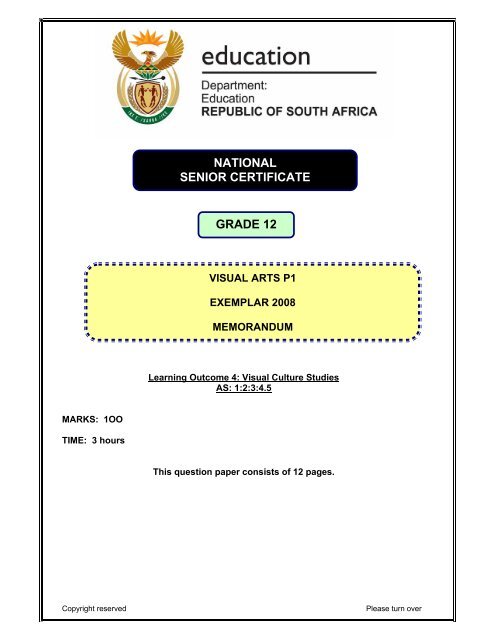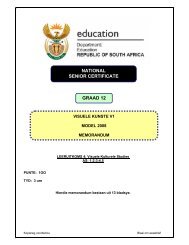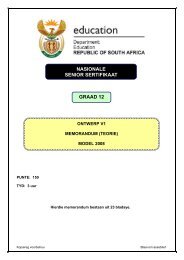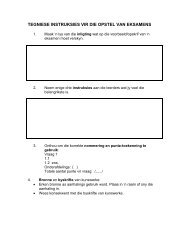national senior certificate grade 12 - FET Design & Visual Arts ...
national senior certificate grade 12 - FET Design & Visual Arts ...
national senior certificate grade 12 - FET Design & Visual Arts ...
- No tags were found...
You also want an ePaper? Increase the reach of your titles
YUMPU automatically turns print PDFs into web optimized ePapers that Google loves.
NATIONALSENIOR CERTIFICATEGRADE <strong>12</strong>VISUAL ARTS P1EXEMPLAR 2008MEMORANDUMLearning Outcome 4: <strong>Visual</strong> Culture StudiesAS: 1:2:3:4.5MARKS: 1OOTIME: 3 hoursThis question paper consists of <strong>12</strong> pages.Copyright reservedPlease turn over
<strong>Visual</strong> <strong>Arts</strong>/P1 2 DoE/Exemplar 2008NSC - MEMONDARUMINSTRUCTIONS AND INFORMATIONRead the following instructions carefully before commencing marking:1. This exam paper consists of TEN questions. Learners must answerany FIVE questions for a total of 100 marks.2. It is MOST IMPORTANT that allowance is made for the learner in manyinstances. Learners must be given credit for providing their ownopinions and ideas in answers. Credit must also be given for lateralthinking. However it is also important that arguments and statementsare well reasoned and qualified by reference to specific factors.3. Questions and sub-sections must be numbered clearly and correctly.4. Information and art works discussed in one answer must not becredited if repeated in other answers but art works may be crossreferenced.5. Learners must name the artist and title of each artwork mentionedwhere applicable.6. Learners may discuss both two and three-dimensional art works in anyquestion where appropriate.7. It must be remembered that many learners will be discussingthese examples, never having seen them before. We thereforecannot expect factual, academic information. They should drawupon their own experiences, cultures and interpretations of the artworks, within the context of the question. Therefore markers needto be open-minded and flexible in the marking process.Copyright reservedPlease turn over
<strong>Visual</strong> <strong>Arts</strong>/P1 3 DoE/Exemplar 2008NSC - MEMONDARUMGENERAL COMMENTS FOR MARKERS• Learners must answer all their questions in FULL SENTENCES or PARAGRAPHSwhere applicable. Point form answers cannot receive full marks.• Markers must refer to the <strong>Visual</strong> Art SAG document rubric to obtain a guideline tohelp them assess the levels of achievement.Assessing learners’ ability to analyse and respond to examples of visual cultureACHIEVEMENTRATING CODE7Outstanding80-100%6Meritorious70-79%5Substantial60-69%4Moderate50-59%3Adequate40-49%2Elementary30-39%1Not achieved0-29%LEARNING OUTCOME 4: VISUAL CULTURE STUDIESDemonstrates exceptional ability to respond to and analyse artworks inrelation to their cultural, social, political and historical contexts.Shows outstanding ability in the use of appropriate visual arts terminology.Demonstrates extremely well-developed writing and research skills in thestudy of art.Shows exceptional insight and understanding and uses divergentapproaches.Demonstrates a well-developed ability to respond to and analyse artworks inrelation to their cultural, social, political and historical contexts.Shows excellent ability in the use of appropriate visual arts terminology.Demonstrates highly developed writing and research skills in the study ofart.Shows excellent insight and understanding.Demonstrates substantial ability to respond to and analyse artworks inrelation to their cultural, social, political and historical contexts.Shows substantial competence in the use of appropriate visual artsterminology.Demonstrates well-developed writing and research skills in the study of art.Shows a good level of insight and understanding.Demonstrates moderate ability to respond to and analyse artworks inrelation to their cultural, social, political and historical contexts.Shows moderate competence in the use of appropriate visual artsterminology.Demonstrates competent writing and research skills in the study of artShows a fair level of insight and understanding.Demonstrates adequate ability to respond to and analyse artworks inrelation to their cultural, social, political and historical contexts.Shows adequate competence in the use of appropriate visual artsterminology.Demonstrates adequate writing and research skills in the study of art.Demonstrates only basic ability to respond to and analyse artworks inrelation to their cultural, social, political and historical contexts.Shows little ability in the use of appropriate visual arts terminology.Demonstrates basic writing and research skills in the study of art.Demonstrates little or no ability to respond to and analyse artworks inrelation to their cultural, social, political and historical contexts.Shows extremely limited ability in the use of appropriate visual artsterminology.Demonstrates limited writing and research skills in the study of art.Shows little or no understanding or insight.Copyright reservedPlease turn over
<strong>Visual</strong> <strong>Arts</strong>/P1 4 DoE/Exemplar 2008NSC - MEMONDARUMQUESTION 1<strong>Visual</strong> sourcesThe emerging voice of Black Art in the 50s and 60s- Peter Clarke, Wind blowing on the Cape Flats- Gerard Sekoto, Yellow houses – a street in Sophiatown1.11.2Learners must look carefully at both works provided in order to discuss andcompare them adequately.• Both Clarke and Sekoto portrayed scenes from settlements outside citycentres. Clarke gives a view of the Cape Flats with people struggling tomove in die wind blowing on the sand dunes. Sekoto gives a view of aSophiatown; observing the houses, everyday activities of the people,etc. Both give us a view of the life of poor, disadvantaged people.• Both made use of perspective – both linear and aerial. Learners canrefer to specific elements to show their understanding of perspective,e.g. things getting smaller towards the back to give the viewer a senseof distance.• In Clarke the girl with the bag forms the focal point as she is thebiggest shape and is placed in the centre of the painting. The lines ofthe grass and the shadow of her legs leads the eye to her. In Sekotothe lines created by the fence and the houses leads the eye ‘inside’ thepainting; the three figures form an area of focus.• Clark simplified his shapes; they are generalized shapes and do notshow individual features, e.g. the box-like houses, etc. Sekotoobserved and painted what he saw e.g. the garden in front becomespatches of colour, etc.• Clarke used stylization by simplifying the shapes, e.g. the ripples ofthe sand blowing on the dunes become patterns, etc. Sekoto usedobservation to create reflections of his society in a very painterlymanner. Learners may show their understanding of style by referring toinfluences from Modernist movements.(10)• Learners may choose any of the works. Marks are given to the reasonsfor their choice which must be related to the specific painting.(2)1.3Learners to choose any other overseas artist that they have studied.They must include the following information:• Name of the artist• Title/s of any work/s discussed• Relevance of artwork/s to question, i.e. use of art elements, imagery,message and technique.(8)utlook ETOTAL [20]Copyright reservedPlease turn over
<strong>Visual</strong> <strong>Arts</strong>/P1 5 DoE/Exemplar 2008NSC - MEMONDARUM\QUESTION 2 Search for an African identity in South Africa since 1950<strong>Visual</strong> sources- Cecil Skotnes, Conversation- Walter Battiss, Rock Artist2.<strong>12</strong>.2Learners must study both works in order to discuss how an African identity iscreated in their art works:- Influences: San Rock art – use of elongated figures.- African tribal art – mask like quality.- Simplification of form.- Reduction of form to basic shapes.- Lack of depth/2dimensional quality- Any other valid information the learner provides.Learners to discuss any TWO artists they have studied who address their owncultural identity.They may use any of the following aspects as a guideline for in their answer:• Inspiration / influence – culture/symbols/etc• Communication of a cultural identity – how has it been used in theart work?• Formal elements• The art making process – and mediumLearners may also include any other themes and messages that areconveyed through these artworks. For example as South African artist maybe influenced by - use of bright strong colour that reflects our landscape,imagery and symbols that refer to our past/origins/roots/culture, the theme ofthe work, etc.(5)(15)Total [20]Copyright reservedPlease turn over
<strong>Visual</strong> <strong>Arts</strong>/P1 6 DoE/Exemplar 2008NSC - MEMONDARUMQUESTION 3 Art & Politics: “Resistance” art in the 70s & 80s<strong>Visual</strong> sources - Jane Alexander, The Butcher Boys- Norman Catherine, Dog of WarLearners must discuss and compare the ways in which the oppressors areportrayed in the visual sources.In the Butcher Boys the following can be discussed:• Title – could refer to these figures that ‘butchered’ the oppressed (bothphysically and mentally) and through this became ‘butchered’ themselves(lost their humanity); the ‘boys’ could refer that they are mentally not men, butboys (the term ‘boy’ was used during Apartheid days to refer to a Black man);through their acts they became inhuman like pieces of meat in a butcher’sshop, etc.• It is a life-size sculpture that makes use of naturalistic shapes ofhuman bodies e.g. the legs and the hands, but this is mixed with the inclusionof real animal bones and horns. The faces have been distorted e.g. no ears,mouths and have snouts for noses.• The colour is unnatural – ghost-like figures. The contrast with the darkbench they are seated on.• Smooth textures of the bodies are contrasted with the rough texture ofthe bones.• The inclusion of the animal elements (horns, bones, snouts, etc.) refersto their becoming inhuman and animal-like, because of their deeds asoppressors.• Any other relevant information must be credited.In the Dog of War the following can be discussed:• Title – The main figure in this work is a mixture of man and animal(dog) and refers to the police/authority figure (the cap). This figure is creatinga scene of devastation (war) with all the mutilated bodies around it.• It is a black and white etching (print). There is a distinct contrast withthe darker figure of the main figure against the lighter background. Theshapes are distorted and simplified (the teeth, eye, etc.)• There are lots of different textures in the work e.g. the fur on the body:patterns and mark-making in the background.• The mixture of man and animal clearly refers to the police and otherauthority figures as being seen as ‘dogs’ during the Apartheid-era. His tongueis shown as a snake.• Choice of medium: The Butcher Boys is more confrontational as a 3dpiece as it invades our space or we invade theirs. The tactile quality of thematerial repulses us, or draws us in to “touch” it.Dog of War is an etching and thus the strong black and white contrast. Thismight be a link to newspaper political cartoons that represented similarimagery during the Apartheid period.• Any other relevant information must be credited.Copyright reservedLearners to choose any South African artist that responded to the apartheidsystem and/or other issues affecting our society.• Name of the artist• Title/s of work/s discussed• Relevance of art work/s to question, i.e. content, message, imagery,use of art elements, message and technique.Please turn over
<strong>Visual</strong> <strong>Arts</strong>/P1 7 DoE/Exemplar 2008NSC - MEMONDARUMTOTAL: [20]QUESTION 4Craft and Applied Art<strong>Visual</strong> sources– Ndebele inspired fashion- Esther Mahlangu, Untitled- Esther Mahlangu, SA Ahead- Esther Mahlangu, Painted BMW4.14.24.3Debate is about the work process, use of materials and ideas.Both can be aesthetically pleasing.Craft focus on the functional.High Art focus on ideas, personal self expressions of the artist.Figure 4a: Wearable.Figure 4b: Painting – exhibited on the wallFigure 4c: Some people might choose to wear these and others to exhibitthem.Figure 4d: Can be used, but also preserved in a museum• Economic empowerment – women, disadvantaged communities• Job creation• Cultural tourism• Makes people proudly SA• Eco-friendly (recycling waste)• Perpetuating the craft tradition (becoming a commodity)Learners must choose any other South African craft-artist that they havestudied.They must include the following information:• Name of the artist• Materials and techniques used• Examples of work(5)(5)(10)TOTAL [20]Copyright reservedPlease turn over
<strong>Visual</strong> <strong>Arts</strong>/P1 8 DoE/Exemplar 2008NSC - MEMONDARUMQUESTION 5Art & Power – commemorative buildings, memorials & artworks<strong>Visual</strong> sources- The Arch of Constantine. Rome- Voortrekkermonument Gerhard Moerdyk- The Seagram Building, Mies van der Rohe.- De Beers Building Helmut JahnLearners must write an essay between 2 – 3 pages that refers to thestatement given. Whether referring to the images provided or those of theirown choice, they must debate/discuss how man has used certainstructures/buildings to express his sense of power or status or both.The structures may be religious, spiritual, commemorative, political,corporate, etc.Learners should be able to indicate how this sense of power or status hasbeen expressed through;- The design of the building/structure- The use of building materials, style, site, size or dominanceon the landscape/cityscape.- The purpose- The function- The use of decorative features that may appear somewhereon the structure, which enhances this message. These maybe in the form of relief sculpture, mural painting, mosaicwork, signage, etc.Learners need to also give their own response to the meaning /significance ofthese examples with sufficient justification.TOTAL: [20]Copyright reservedPlease turn over
<strong>Visual</strong> <strong>Arts</strong>/P1 9 DoE/Exemplar 2008NSC - MEMONDARUMQUESTION 6 Role of Formal and Informal Art Centres<strong>Visual</strong> sources - Dan Rakgoathe Council of Solace- Cyprian Shilakoe Lets wait till they arrive6.1 Learners must look carefully at both works provided in order to discuss andcompare the use of elements, technique and mood created.• Rakgoathe makes use of sensitive white and black line due to thelinocut process. Line also allows him to successfully create interestingpatterned areas which in turn contrast against the solid black shapes ofthe figures. The use of positive and negative shape is very strong inthe work of both artists.6.2• Shilakoe creates a moody composition due to the interesting variationof tone he has managed to create in his work. The dark face on the leftof the composition contrasts greatly with the lighter background. Thedeliberate use of distortion to create strangely naïve figures with largestarting innocent eyes.Learners must discuss and analyse the work of any TWO artists they havestudied that trained at either Rorke’s Drift, Polly Street, or Nyanga ArtCentres. They must also mention the important role these centres played inthe training of black artists.• For the first 50 years of the 20 th century there were no art schools ortraining centres that black artist could attend. However, artists who didmake a living from their work were largely self-taught. The firstsignificant art centre established within the Black community was thePolly Street Centre later called Jubilee Art Centre.• Importance of Polly street in the history of South African art:o It was from the centre that the first generation of Blackprofessional artist came.o The “Township” school arose as many artist trained there beganworking in this way.o The art made by artist in South Africa (both White and Black)became rooted in Africa rather than following on the lead ofEuropean tradition.• Rorke’s Drift: Its aims were to nurture the unique artistic heritage ofAfrica, and to extend this heritage with new influences so that it wouldfinds its rightful place in an evolving and changing society.• The centre also aimed to develop with the changing society, to extendits teaching influence and to find increasingly profitable outlets for workwhich would help raise the living standards of local clack people bygiving them work and an income.Learners to choose work by two artists that studied at one of these art centre.In their discussion they should include the following information:• Name of the artist• Title of work/s discussed• Relevance of artwork/s to question, i.e. content, message, imagery,use of art elements, message and technique.(8)Copyright reservedPlease turn over
<strong>Visual</strong> <strong>Arts</strong>/P1 11 DoE/Exemplar 2008NSC - MEMONDARUMQUESTION 8<strong>Visual</strong> sourcesArt & the spiritual realm- Wim Botha Commune: Suspension of Disbelief- Jackson Hlungwane God and Christ- Peter Schütz Durban Icon8.18.28.3The use of Bibles and Bible text works on many levels:• It makes a connection between the religious “word” and the religious“image”. (crucifix)• It confronts the view in terms of its useo The novelty of using a religious item/s as art material.o Sacrilegious to desecrate the Bible.• Telephone directories could have used to create the form of thesculpture, but there would be no link to the religious context. It wouldact merely as paper/substance and nothing further.Learners must compare and discuss the two works (Figure 8b and 8c) interms deciding which they relate to more as a religious/spiritual piece.Hlungwane “God and Christ” 1990.o He expresses his own religious world.o He has carved the piece using traditional sculptural materials andtechniqueso He has made use of deliberate distortion/abstraction to put across hispersonalized interpretation of this subject matter.o Wood is left rough and texturedPeter Schütz “Durban Icon”.o Has made use of wood carving but has also painted certain areas ofthe sculpture.o The figure is easier to identify as it is more representationalo It has a regal and noble stance – portrays a sense of spiritualityo The title may confuse the viewer – is it religious or not – he providesclues. On the one hand the stance, robe and staff are indicative of apriest, but then the “rickshaw” headdress speaks of something else.However, the headdress is painted gold and alludes to a halo.o The religious staff held in each hand could also be interpreted as theancestoral regalia used by Zulu men, or the candyfloss/ice cream coneshapes bought at the Durban beachfront!o The figure wears a long flowing robe similar to that worn by membersof the clergyo The contrast between the light wood and the dark skin also createvisual interest.Learners must discuss the work/s of any other artist they have studied whosework also communicates a strong religious/spiritual message. They mustincludeo Name of the artist and title of work/s.o Medium used.o Message/content of the work/s.(3)(5)(<strong>12</strong>)Copyright reservedTOTAL: [20]Please turn over
<strong>Visual</strong> <strong>Arts</strong>/P1 <strong>12</strong> DoE/Exemplar 2008NSC - MEMONDARUMQUESTION 9<strong>Visual</strong> sourcesGender issues in SA art- Advertisement- Allen Jones, Chair and Girl table- Lisa Brice, Sex Kitten Cheap Cheap- Lisa Brice, What is a home without an armed mother?9.1• The advertisement uses the image of a bride, something that girls,according to most societies, should aspire to. The bride in her white(virginal) finery is being protected by the groom in black. This image isused to convey the idea that the perfume will recreate these feelings –making the woman feel protected, happy, etc.• All the images deal with stereotypes. The smiling bride, leaning on herhusband (Figure 9a), the sex doll to serve the man (Figure 9b), theseductress (Figure 9c) and the hard-working housewife (Figure 9d).• In Sex Kitten Cheap, Cheap the following can be discussed:- The first part of the title refers to her posture – on her knees in atypical pin-up position.- The Cheap Cheap refers to refers to money. Copies of moneynotes (the dollar bill, etc.) have been used to construct thefigure. This could refer to the money involved in the sex industryand specifically, prostitution. Women like these not have achoice and must sell their bodies to survive.- The cut-out shape places the focus totally on the woman,emphasising the sexual parts – open lips, breasts, open legs,etc.• In What is a home… the following can be discussed:- the title refers to the old saying of “What is a house without amother”.- The figure is covered in linoleum and shown washing a floor.Traditionally linoleum was used for kitchen floors.- She is submissive.- The …without an armed mother, refers that she should beprepared to protect her children, but also to the South Africancontext in general.• Any other relevant ideas that can directly apply to the images may beconsidered.(<strong>12</strong>)9.2Learners to choose one specific work by any artist that have exploredfeminist/women issues or any other issue regarding gender.They must include the following:• Name of the artist and title of the artwork• Briefly describe the artwork, especially if it is of a more conceptualnature.• Analyse it in term of the art elements.• Refer how the above helps to express a specific issue relating togender by discussing the content and message of the work.(8)TOTAL: [20]Copyright reservedPlease turn over
<strong>Visual</strong> <strong>Arts</strong>/P1 13 DoE/Exemplar 2008NSC - MEMONDARUMQUESTION 10 Contemporary Architecture in South Africa<strong>Visual</strong> source- A typical South African cityscape10.1Learners give their own opinion;Agree: Refer to traces of e.g. Baroque, Inter<strong>national</strong> style, Modernism,Late/Post Modernism, Tuscan, Balinese, Tudor, etc.10.2Disagree:They may feel that most architects have incorporated an Africanelement in his/her work through the use of indigenous materials- indigenous decorations (simple geometric shapes, strongcolour or earthy tones)- climate and environment: large windows, north facing,Learners give their own opinion why it is important that our architecture reflecta distinct SA style, e.g. to suit our unique climate/ landscape/cultures, proudlySA, to reflect the talent and creativeness of SA architects,(3)(3)10.310.4Learners give their own opinion. Award marks for insight into the challengesfacing architects when designing a building, e.g. size, cost, materials,construction, area, style, surroundings, climate, challenges on site likeexcavations, etc.Learners must discuss ONE example which they feel reflects our SouthAfrican culture/identity/needs. This may be shown through a discussion of thefollowing:• design• use of building materials and techniques• site of the structure• decorative elements• etcLearners must name the example discussed as well as the architect.(4)(10)TOTAL: [20]Copyright reserved








